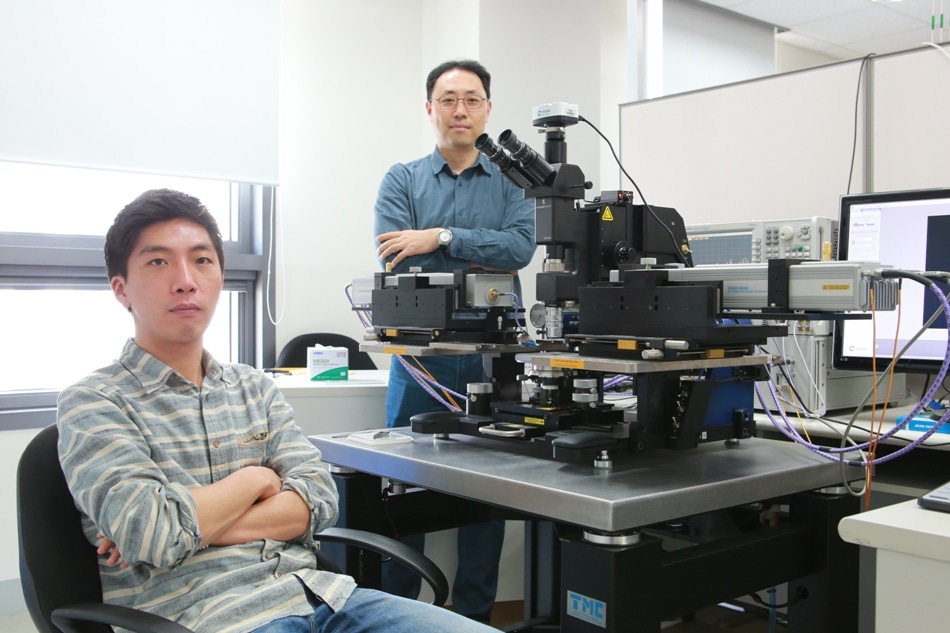May 9 2019
A graphene-based high-performance transmission line with enhanced operating speed of electrons compared to using the existing metal in high frequency has been developed by the DGIST Department of Information and Communication Engineering.
 Ph.D. candidate Jae-hoon Yang (left) and Professor Jae Eun Jang (right) in the DGIST Department of Information and Communication Engineering. (Image credit: DGIST)
Ph.D. candidate Jae-hoon Yang (left) and Professor Jae Eun Jang (right) in the DGIST Department of Information and Communication Engineering. (Image credit: DGIST)
This is supposed to contribute significantly to next-generation, high-speed semiconductor and communication devices with much more rapid processing speed when compared to the existing ones.
On Thursday, May 2nd, 2019, DGIST announced that Professor Jae Eun Jang’s group studied the high-frequency transmission characteristics of single-layer graphene in the Department of Information and Communication Engineering and created a high-performance, high-frequency transmission line that brought about an increase in device concentration within graphene. The study outcome demonstrated the characteristics of high-frequency transmission with a significant enhancement that can replace the metal used in the existing high-speed semiconductor processing, and its promising use as a transmission line of graphene is anticipated in the future.
The high integration and high speed of semiconductor devices have made the resistance of metal wire in which signals among devices are sent to increase geometrically, reaching the limit of allowable current density. In order to overcome this problem, carbon-based nano-structures such as carbon nanotube and graphene, which are considered as replacements to existing metals, have gained attention as next-generation new materials.
However, graphene is made up of a hexagonal array of carbon, with electric conductivity that is 100 times better than copper, thickness as less as 0.3 nm, and electron mobility that is 100 times more rapid than silicon. Therefore, it has been referred to as an electronic material that can be used instead of the existing semiconductor materials and metals. However, pure graphene has a device concentration as low as 1012 cm−2 with thin structural characteristics of nanometer, which leads to extremely high resistance of graphene.
In order to solve such problems, the team led by Professor Jang carried out a study to enhance high-frequency transmission characteristics of graphene by improving the device concentration within graphene. The team increased the device concentration of graphene and improved its electrical characteristics by combining graphene and amorphous carbon. The high-frequency transmission of improved graphene was −8 dB, which could be analogous to metal nano-lines with hundreds of nano-size.
Furthermore, the group proved that flaws within graphene reduce the high-frequency transmission of graphene and created a new, stable doping method that reduced internal defects. This new doping method improved the device concentration of graphene by 2 x 1013 cm−2 and demonstrated stable thermal properties and electrical characteristics.
The high-frequency graphene transmission line created by Professor Jang’s research group exhibited high signal transmission efficiency and stable operating characteristics, which can be applied to the metal wiring processing of the existing semiconductor industry as well as next-generation integrated circuit.
Along with device technology, transmission line is a very important technology in the semiconductor research field. We have developed a core base technology that can enhance the high frequency transmission of graphene that can be used as next generation transmission line. Thanks to the results of convergence research by experts in nano engineering, electronic engineering, and physics, we expect to use the graphene on high-frequency circuit such as MMIC and RFIC.
Professor Jae Eun Jang, Department of Information and Communication Engineering, DGIST
This study was carried out with the support of the Ministry of Science and ICT and basic research project of the National Research Foundation of Korea, and it has been chosen to be published as a cover paper of Advanced Functional Materials, a worldwide international journal in material science.